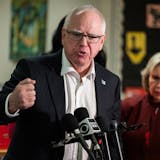Henry Williams coached University of Minnesota football for 22 seasons at the start of the 20th century. Murray Warmath ranks as the second longest-serving Gophers coach, with 18 seasons from 1954 through 1971.
Phillip John Fleck starts his competitive tenure with the woeful Buffalo Bulls (not to be confused with the woeful Buffalo Bills) on Thursday night. Fleck will turn 37 on Nov. 29 and has a chance to eventually rank high on the Gophers' seniority list for coaches.
Fleck will be the 10th full-time head coach since Warmath was forced out in 1971. It's not a news bulletin that a majority of those coaches were hired to dredge up the Gophers from near the bottom of the Big Ten, although that's not always been the case.
As someone who has observed the Gophers going in and out of all 10 coaching changes, here's a bit of a ranking — from most difficult situation inherited (10) to the least difficult (1) — for coaches taking over at Minnesota.
10. Lou Holtz (1984): Joe Salem had lost 18 of his last 19 games as coach. The '83 Gophers were 1-10 and gave up 50 or more points six times, including 69 to Ohio State and 84 to Nebraska.
Holtz stayed only two seasons before leaving for Notre Dame. While here, he forced the university to raise the budget for assistants and to raise funds for what would serve as the football practice building for three decades. Holtz left with the 6-5 Gophers scheduled to play in the 1985 Independence Bowl in Shreveport, La.
9. Glen Mason (1997): Likable though he was, Jim Wacker was a five-season disaster for the Gophers — 8-32 in the Big Ten, and 17-39 overall. Mason and his staff started off by improving the talent on hand through coaching.
They also changed offensive strategy. Wacker's teams tried to outscore opponents throwing the ball. Mason built a mighty running game that would have a chance to protect a defense that generally was going to be limited in speed.

![A black bear stopped after crossing Big Bay Road on Madeline Island, the largest of the Apostle Islands in Wisconsin, on Monday, May 31, 2021. ]](https://arc.stimg.co/startribunemedia/PWNYGIY3WTSWDBOGOYD775DPP4.jpg?&w=80&ar=1:1&fit=crop)

